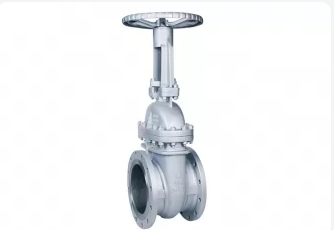Introduction to Gate Valve
Gate valves are used to shut off the flow of fluid by inserting a rectangular gate or wedge into the path of a flowing fluid. Gate valves require very little space along the pipe axis and hardly restrict the flow of fluid when the gate is fully opened enabling gate valves to offer straightway flow with very little pressure drop. Gate valves are mostly used with larger pipe diameters (from 2″ to the largest pipelines) since they are less complex to construct than other types of valves in large sizes. More recently, however, the larger sizes have been supplemented by butterfly valves due to space limitations under which they are installed.
The gate valve, as illustrated in on the right, generally consists of a gate-like disc, actuated by a screwed stem and hand-wheel which moves up and down at right angles to the flow. In the closed position, the disc seats against two faces to shut off flow. To retain the fluid in the pipeline, a gland is provided which is supplied with some type of packing to resist leakage.
Gate Valve Working Principle
Gate valves consist of three major components: body, bonnet, and trim. The body is generally connected to the piping by means of flanged, screwed, or welded connections. The bonnet, containing the moving parts, is joined to the body, generally with bolts, to permit cleaning and maintenance. The valve trim consists of the stem, the gate, the wedge, or disc, and the seat rings.
The main operation mechanism is very simple. When the hand-wheel is turned, it rotates the stem, which is translated into the vertical movement of a gate via threads. They are considered multi-turn valves as it takes more than one 360° turn to fully open/close the valve. When the gate is lifted from the path of the flow, the valve opens and when it returns to its closed position, it seals the bore resulting in a full closure of the valve.
Use of Gate Valves
Gate valves meet the majority of valve requirements in process piping and are considered one of the most used valves of all the valves employed in refineries, petrochemical, and gas processing plants where pressure remains relatively low, but temperature may be very high. They are suitable for most fluids including steam, water, oil, air, and gas.
Gate valves are designed for fully open or fully closed service. They are installed in pipelines as isolating valves, and should not be used as flow control or regulating valves. When operating the valve stem, the gate moves up- or downwards on the threaded part of the stem.
Gate valves are often used when minimum pressure loss and a free bore is needed. When fully open, a typical gate valve has no obstruction in the flow path resulting in a very low pressure loss, and this design makes it possible to use a pipe-cleaning pig. A gate valve is a multiturn valve meaning that the operation of the valve is done by means of a threaded stem. As the valve has to turn multiple times to go from open to closed position, the slow operation also prevents water hammer effects.
CNM VALVE provide total valve solutions, which specializes in R&D, design, manufacture, sales, and service. Choose us, you can get most careful and thoughtful service!
